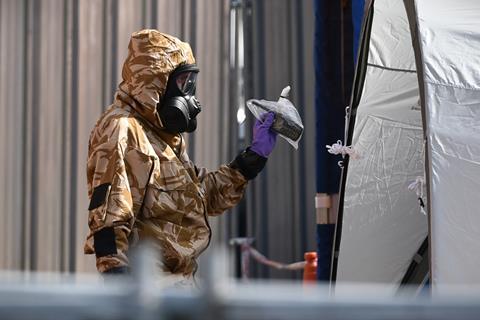
Police have located the source of a fatal poisoning in the UK town of Amesbury, involving the same Novichok nerve agent used in the assassination attempt on a former Russian spy in nearby Salisbury earlier this year.
Tests at the Defence Science and Technology Laboratory revealed a small bottle found in the house of one of the victims – Charlie Rowley – was contaminated with the nerve agent. Investigators had been looking for a container handled by Rowley and his partner Dawn Sturgess who were both taken ill and rushed to hospital on 30 June. It was later established their symptoms were due to poisoning with a Novichok agent. Sturgess has since died and Rowley remains in intensive care.
Police say they have been working under the assumption that the poisoning is related to that of Sergei and Yulia Skripal in March, but are still unsure exactly what happened.
Engineered to persist
There is little publicly available information about this class of nerve agents, but this latest incident – and the way officials have been dealing with it – suggests they are designed to be persistent in the environment, unlike the nerve agent sarin, which is volatile and breaks down rapidly.
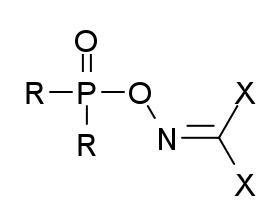
The fact that samples of the original compound – rather than breakdown products – were found on the bottle as well as the victims’ hands and clothing suggests it is relatively stable, and that the couple became ill as it absorbed through their skin over a period of time, says Andrea Sella, a chemist at University College London in the UK. ‘I think these compounds have been engineered so that that phosphorus–nitrogen bond that they all have is much more robust,’ he tells Chemistry World. ‘By putting the longer chains on the nitrogen they’re also less water soluble. In moderate containment [they] will be there for a very long time, just as a tin of paint will be there for a very long time when you put the top back on.’
Now that police have identified the bottle that was handled by the two latest victims they will be working to test whether the Novichok is from the same batch that poisoned the Skripals. Sella says finding the bottle was a ‘major breakthrough’ in the investigation. ‘The discovery is a forensic gold mine. Not only is having a significant quantity of sample a real treasure trove to make detailed investigations of the sample, the bottle itself is likely to provide significant clues about its provenance.’
Novichok nerve agents: what we know
- Novichoks work by disrupting the body’s nervous system. They bind to a serine amino acid in the enzyme acetylcholinesterase, which normally breaks down the neurotransmitter acetylcholine. As the acetylcholine builds up, the victim can suffer from convulsions, paralysis and respiratory arrest that can cause death. Victims can be treated with drugs such as pralidoxime that break the bond between the nerve agent and the enzyme.
- They were developed in Russia as part of a secret chemical weapons programme in the 1970s and 80s. The word ‘novichok’ means ‘newcomer’. They are binary agents formed by mixing two relatively benign precursor chemicals just before use, which makes them safer to handle.
- For security reasons, there is little publicly accessible information about the compounds themselves and how they are made. They are thought to be organophosphates similar in structure to the nerve agent VX. What we do know comes from Russian whistleblowers and chemists in Iran who synthesised small Novichok samples to analyse them.
- In April 2018, independent investigators from the Organisation for the Prohibition of Chemical Weapons verified that a Novichok agent was used in the attempted assassination of former Russian spy Sergei Skripal in Salisbury, UK. The agency came to no conclusion on who was responsible for the poisoning as this was not part of its remit at the time. This has now changed.
Cleanup operation
As well as investigating the source, scientists will be making efforts to decontaminate the areas that could have come into contact with the nerve agent.
Rowley and his partner potentially visited a number of locations in Salisbury and Amesbury in between being exposed and falling ill, including private residences in both towns, a church, a pharmacy and Queen Elizabeth Gardens in Salisbury. Police cordons are still in effect around some of these areas, although as the bottle was found in Rowley’s house the risk to the public is thought to be low.
Robert Chilcott, a professor of toxicology at the University of Hertfordshire, UK, says that any Novichok in an open environment will degrade over time. ‘You’ll have weathering effects – the effects of bacteria, direct sunlight and, normally, dilution [from rain]. If you look at [the nerve agent] VX, the half-life in the environment is about three to five days.’
He adds that investigators may remove items for public reassurance – paving slabs and soil in some parts of Salisbury were taken away after the Skripal poisoning, for example. But most decontamination efforts are likely to be chemical-based.
‘Decontamination is not particularly hard because alkaline hydrolysis is very effective [on nerve agents],’ says Sella. ‘The cleanup operation involves essentially either using bleach or caustic soda, and just scrubbing surfaces to make sure they’re clean. That converts them to phosphate and the other bits and pieces, and it all becomes near enough harmless.’
‘The risks are incredibly low unless you come into contact with that object, because it isn’t volatile and it’s not water soluble,’ he adds. ‘The real issue is could there be a second container or a third or a fourth? Nobody knows anything about the [poisoners’] modus operandi.’
As a precaution, Public Health England has issued advice to people in the area not to touch any foreign objects that could have contained liquid or gel, including containers, lids, syringes or needles.
The question of how the Novichok-containing bottle came to be in the couple’s possession in the first place remains unanswered.





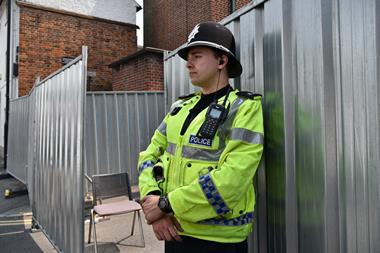
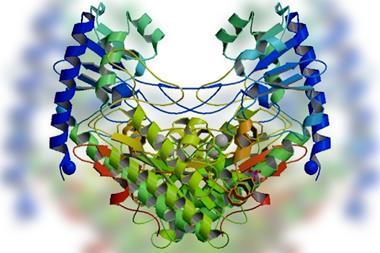
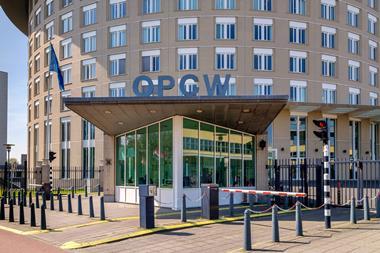

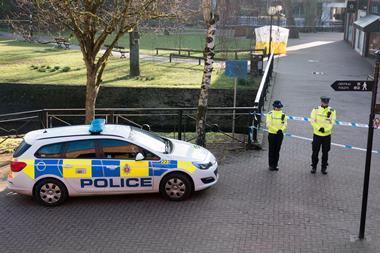







4 readers' comments